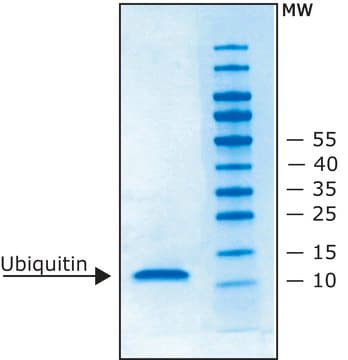MABS451
Anti-Linear Ubiquitin Antibody, clone LUB9
clone LUB9, from mouse
Synonym(s):
Polyubiquitin-C, Ubiquitin
Sign Into View Organizational & Contract Pricing
All Photos(1)
About This Item
UNSPSC Code:
12352203
eCl@ss:
32160702
NACRES:
NA.41
Recommended Products
biological source
mouse
Quality Level
antibody form
purified immunoglobulin
antibody product type
primary antibodies
clone
LUB9, monoclonal
species reactivity
human
technique(s)
western blot: suitable
isotype
IgG2bκ
NCBI accession no.
UniProt accession no.
shipped in
wet ice
target post-translational modification
unmodified
Gene Information
human ... UBC(7316)
General description
Ubiquitin functions as a marker to indicate the fate of other proteins in the cell. It can be attached as a single molecule or as a polyubiquitin chain. Although ubiquitinated proteins are oftentimes tagged for degradation by the 20S proteosome, ubiquitination can also indicate alternative fates depending on the lysine residue that is involved in linking the ubiquitin chain to the target protein. Ubiquitin chains linked by Lys33 to kinase substrates such as AMP-activated protein kinases, (AMPKα1, BRSK1, MARK3, MARK4, and NUAK1), may activate or deactivate these proteins, supporting the role for uniquitin in regulating signaling.
Specificity
This antibody detects only Linear Ubiquitin.
Immunogen
Ovalbumin-conjugated linear peptide corresponding to human Linear Ubiquitin.
Application
Anti-Linear Ubiquitin Antibody, clone LUB9 | MABS451 is an antibody against Linear Ubiquitin Antibody for use in Western Blotting.
Research Category
Signaling
Signaling
Research Sub Category
Signaling Neuroscience
Signaling Neuroscience
Western Blotting Analysis: A representative lot detected Linear Ubiquitin in (M1-linked) ubiquitin chains (Yoshiteru, S. et al. (2013). EMBO. 32:2463-2476).
Quality
Evaluated by Western Blotting in recombinant protein Linear Polyubiquitin chains, K48 Ub 2-7, K63 Ub 2-7, and K11-only Ubn-ubiquitinylated HM substrate protein.
Western Blotting Analysis: 1.0 µg/mL of this antibody detected 10 µg of Linear Polyubiquitin recombinant protein chains, bands were not detected in K48 Ub 2-7, K63 Ub 2-7, and K11-only Ubn-ubiquitinylated HM substrate protein.
Western Blotting Analysis: 1.0 µg/mL of this antibody detected 10 µg of Linear Polyubiquitin recombinant protein chains, bands were not detected in K48 Ub 2-7, K63 Ub 2-7, and K11-only Ubn-ubiquitinylated HM substrate protein.
Target description
Multiple bands observed
Physical form
Format: Purified
Protein G Purified
Purified mouse monoclonal IgG2bκ in buffer containing 0.1 M Tris-Glycine (pH 7.4), 150 mM NaCl with 0.05% sodium azide.
Storage and Stability
Stable for 1 year at 2-8°C from date of receipt.
Other Notes
Concentration: Please refer to lot specific datasheet.
Disclaimer
Unless otherwise stated in our catalog or other company documentation accompanying the product(s), our products are intended for research use only and are not to be used for any other purpose, which includes but is not limited to, unauthorized commercial uses, in vitro diagnostic uses, ex vivo or in vivo therapeutic uses or any type of consumption or application to humans or animals.
Not finding the right product?
Try our Product Selector Tool.
recommended
Product No.
Description
Pricing
Storage Class Code
12 - Non Combustible Liquids
WGK
WGK 1
Flash Point(F)
Not applicable
Flash Point(C)
Not applicable
Certificates of Analysis (COA)
Search for Certificates of Analysis (COA) by entering the products Lot/Batch Number. Lot and Batch Numbers can be found on a product’s label following the words ‘Lot’ or ‘Batch’.
Already Own This Product?
Find documentation for the products that you have recently purchased in the Document Library.
Xiangqin Kuang et al.
Cellular & molecular biology letters, 28(1), 62-62 (2023-08-01)
Bladder cancer (BLCA) is a malignancy that frequently metastasizes and leads to poor patient prognosis. It is essential to understand the molecular mechanisms underlying the progression and metastasis of BLCA and identify potential biomarkers. The expression of peptidase inhibitor 16
Seshiru Nakazawa et al.
Nature communications, 7, 12547-12547 (2016-08-25)
Optineurin (OPTN) mutations cause neurodegenerative diseases, including amyotrophic lateral sclerosis (ALS) and glaucoma. Although the ALS-associated E478G mutation in the UBAN domain of OPTN reportedly abolishes its NF-κB suppressive activity, the precise molecular basis in ALS pathogenesis still remains unclear.
Hayley I Muendlein et al.
Proceedings of the National Academy of Sciences of the United States of America, 119(24), e2113872119-e2113872119 (2022-06-07)
ZBP1 is widely recognized as a mediator of cell death for its role in initiating necroptotic, apoptotic, and pyroptotic cell death pathways in response to diverse pathogenic infection. Herein, we characterize an unanticipated role for ZBP1 in promoting inflammatory responses
Esther Hoste et al.
Nature communications, 12(1), 5913-5913 (2021-10-10)
OTULIN is a deubiquitinase that specifically cleaves linear ubiquitin chains. Here we demonstrate that the ablation of Otulin selectively in keratinocytes causes inflammatory skin lesions that develop into verrucous carcinomas. Genetic deletion of Tnfr1, knockin expression of kinase-inactive Ripk1 or
Seshiru Nakazawa et al.
Oncology letters, 24(5), 394-394 (2022-10-25)
The linear ubiquitin chain assembly complex (LUBAC), which is composed of RING finger protein 31 (RNF31), RANBP2-type and C3HC4-type zinc finger containing 1 and SHANK-associated RH domain interactor subunits, is the only ubiquitin ligase to generate Met1-linked linear ubiquitin chains.
Our team of scientists has experience in all areas of research including Life Science, Material Science, Chemical Synthesis, Chromatography, Analytical and many others.
Contact Technical Service







